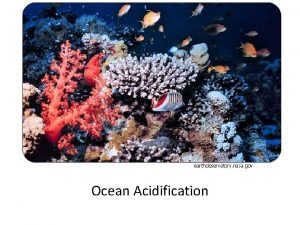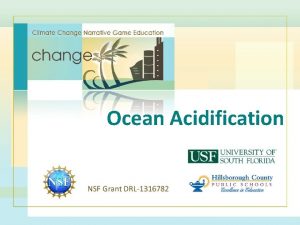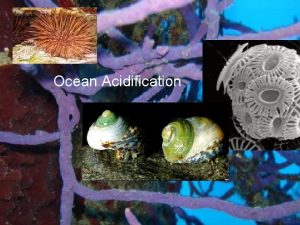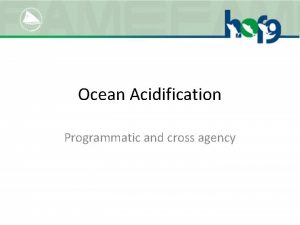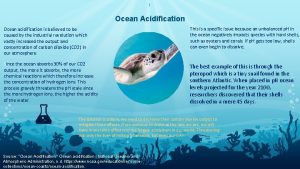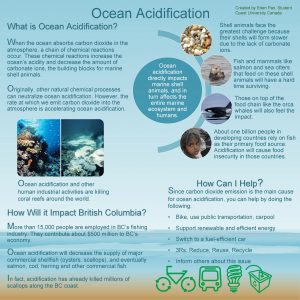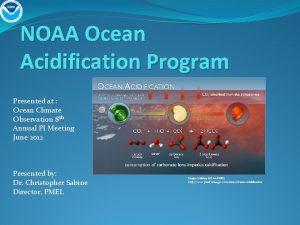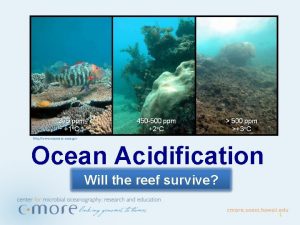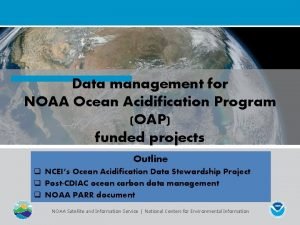Ocean Acidification NOAA California Science Project Ocean acidification











- Slides: 11

Ocean Acidification NOAA California Science Project

Ocean acidification is a process where the p. H of the Earth’s oceans is decreasing (becoming more acidic) as the CO 2 levels in the atmosphere increase. CO 2 is readily soluble in water and ∼ 30 -40% of the anthropogenic CO 2 released into the atmosphere dissolves into the oceans and other water bodies. CO 2 reacts with water molecules form carbonic acid Image by Arnold Paul (Own work (own foto)) [CC-BY-SA-2. 5 (http: //creativecommons. org/licenses/by-sa/2. 5)], via Wikimedia Commons

p. H is a measure of how acid or basic a substance is where Note that water is a weak acid and a weak base and may dissociate where H 2 O ↔ H+ + OHThe lower the value of the p. H, the higher the concentration of H+ and the more acidic the solution. Neutral solutions have a p. H of 7. For acidic solutions, p. H < 7 For basic solutions, p. H > 7 Seawater is naturally basic with a p. H of ∼ 8. Image by Open. Stax College [CC-BY-3. 0 (http: //creativecommons. org/licenses/by/3. 0)], via Wikimedia Commons

Carbon Cycle The amount of carbon contained in the oceans is only second to the amount of carbon stored in the lithosphere. Carbon in the world’s ocean consists of two types: • Organic (derived from the biosphere) • Inorganic (containing no C-H or C-C bonds) Although carbon can be exchanged between these two different forms, inorganic carbon is the primary agent responsible for ocean acidification. CO 2 is readily exchanged between the atmosphere and ocean. Wikimedia User: Hgrobe

Inorganic carbon exchange between the ocean and atmosphere is a control on p. H in the ocean. The diagram shows the movement of carbon between land, atmosphere, and oceans. Yellow numbers are natural fluxes. Red are human contributions (gigatons/year). White numbers indicate stored carbon. Source: U. S. DOE, Biological and Environmental Research Information System.

When CO 2 enters the ocean, it participates in a series of reactions: Dissolution of CO 2: CO 2 (atmospheric) ⇌ CO 2 (dissolved) Conversion of CO 2 to carbonic acid: CO 2 (dissolved) + H 2 O ⇌ H 2 CO 3 carbon dioxide carbonic acid First ionization of carbonic acid to form bicarbonate: H 2 CO 3 ⇌ H+ + HCO 3−(bicarbonate ion) Second ionization to form carbonate ion: HCO 3− ⇌ H+ + CO 32−(carbonate ion) carbonate ion bicarbonate ion

As additional CO 2 is added to the oceans, bicarbonate and carbonate ions are produced. This increases the H ions (acidity) in solution in the ocean’s waters. To maintain chemical equilibrium, carbonate is converted to bicarbonate. Thus, the dissolution of Ca. CO 3 (calcite and aragonite) contained in the shells of organisms favored. Wikimedia User: Be. Ar This figure shows the speciation of inorganic carbon species as a function of p. H. It is clear from this diagram that bicarbonate (HCO 3 -) dominates in the oceans.

This figure shows the estimated change in p. H of seawater from the 1700 s to the 1990 s It is thought that the p. H of ocean surface water will decrease by about 0. 2 by 2100. Source: Wikimedia User Plumbago

• Calculate the increase in the amount of H+ (acidity) if the p. H decreases from 8. 0 to 7. 8. The activity, a, is a measure of the “effective concentration” of H+ ions that are available for chemical reactions – as concentration it would be in units such as (moles H+/liter seawater) but don’t worry about units. Remember that x = log y and y = 10 x • How does the value of the increase in the concentration of H+ ions related to value of p. H? • What is surprising about your results?

At p. H = 8: a = 10 -8 = 1. 00 x 10 -8 At p. H = 7. 8: a = 10 -7. 8 = 1. 58 x 10 -8 The increase in the activity of H+ is 1. 58 x 10 -8 - 1 x 10 -8 = 0. 58 x 10 -8 The %increase in the amount of H+ in ocean water is 0. 58 x 10 -8 x 100 = 58% This is a significant increase in H+ for what 1 x 10 -8 ( ) seems to be a small change in p. H

Ocean acidification will affect marine ecosystems. In particular, ocean acidification will have a dramatic affect on the health and survivability of marine calcifying organisms. Many organisms that form carbonate shells (such as foraminifera, coccoliths, echinoderms, etc. ) form the base of marine food webs. Increasing ocean acidification is expected to lead to a decline in commercial fisheries. World apparent per capita fish consumption has increased from 9. 9 kg in the 1960’s to 16. 4 kg in 2005. Food and Agriculture Organization of the United Nations
 Ocean acidification
Ocean acidification Non calcifiers examples
Non calcifiers examples Science is my favourite subject
Science is my favourite subject So cal science olympiad
So cal science olympiad California science test
California science test Next generation science standards california
Next generation science standards california Science olympiad protein modeling
Science olympiad protein modeling Is a mountain divergent convergent or transform
Is a mountain divergent convergent or transform Ocean ocean convergent boundary
Ocean ocean convergent boundary Ocean to ocean convergent boundary
Ocean to ocean convergent boundary Ocean ocean convergent boundary
Ocean ocean convergent boundary Nekton include all animals that
Nekton include all animals that

